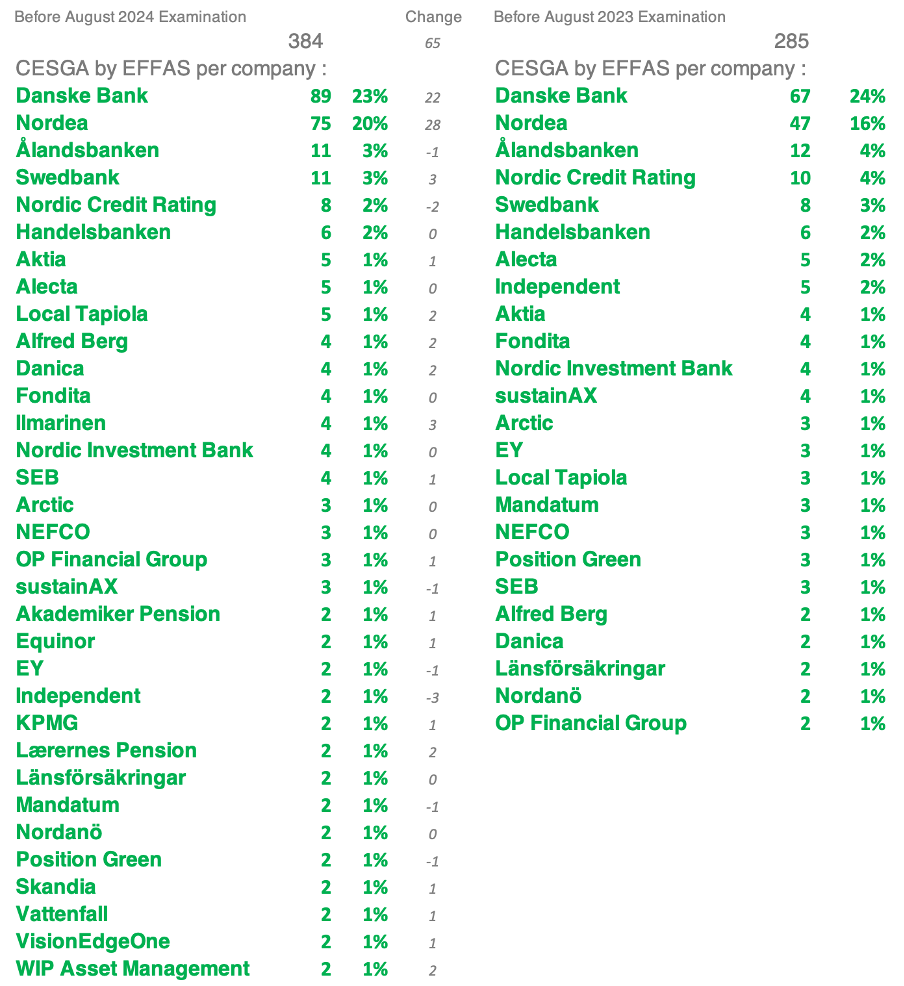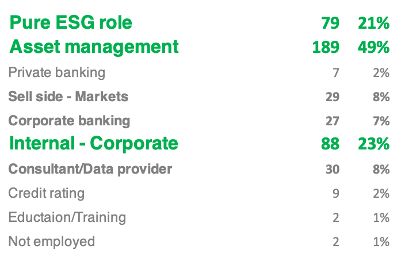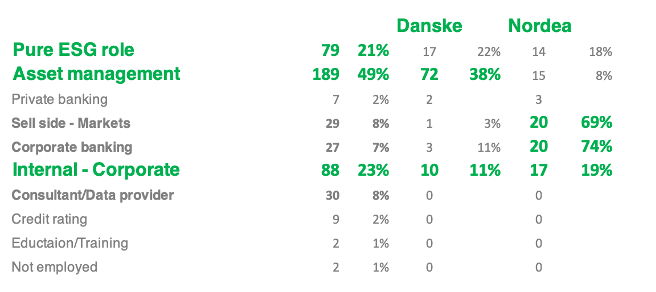Nordic Certified ESG* Analysts Overview #5 – Danske Bank still in front of Nordea, and much more focused on asset management. Norway still lagging, but less!
The finance industry is grappling with a critical issue: the lack of genuine ESG analyst expertise. This challenge is growing more significant as regulations become stricter and expectations from asset owners and other stakeholders rise rapidly. The potential costs of inadequate ESG risk management, ranging from climate costs, regulatory penalties and reputational damage to other adverse impacts on stakeholders, can be substantial.
There are numerous advanced ESG courses available that can elevate ESG beginners to a higher level of understanding. However, there is also a pressing need for formal ESG analyst education in asset management and capital markets. We need experts who can generate comprehensive ESG research reports on investee companies, grounded in a deep understanding of ESG risks, rather than relying on the overly simplistic and superficial checkbox or number crunching approaches that are too common today.
A challenge is that many professionals with ESG education are working in roles outside of portfolio management. To effectively integrate ESG risks into investment decisions, which is now a requirement in the EU, specialized formal training and education are necessary. Simply having an ESG-trained individual in roles like sales, reporting, or compliance does not address this specific need.
To address this, portfolio managers and investment analysts, need to add ESG to their formal educational base, preferably with certification from an international recognised organisation.
At sustainAX, we have had a closer look at where in the Nordics and in what companies we find Certified ESG Analysts (EFFAS). We have only focused on the CESGA as it is the only education of ESG analysts for finance professionals we have found so far requiring a case to be satisfactory solved during the examination to gain the certification. Therefore, we find it the most targeted for assessing individual knowledge of ESG relevant to investing.
ESG risk assessment must be grounded in scientific analysis.
Since our last review in August 2023, 105 new CESGA certifications have been awarded in the Nordics. The CESGA credential is gaining traction, with a growing number of global candidates sitting for the exam each quarter. It’s encouraging to see ESG analyst expertise expanding across the Nordics!
Certified ESG Analysts per country
Thanks to feedback from our readers, we have recognized that teams within organizations may be registered in one country for the exam while being located in another. We have now adjusted our approach to account for this.
Geographically, Sweden continues to lead with the highest number of CESGA certifications, holding 143 adjusted and 207 non-adjusted figures, consistent with our previous report. Relative to their population size Finland, with 111 adjusted and 99 non-adjusted as well as Denmark, with 86 adjusted and 58 non-adjusted, remain ahead of Sweden. Sweden has shown the lowest growth with 17% since the last review, while Norway with 69% had the highest growth, both for adjusted figures.
Norway (with 54 adjusted and 37 non-adjusted CESGAs) continues to lag, which is surprising given the growing interest in ESG. The gap between Norway and its Nordic neighbours, such as Finland and Denmark, is significant. To match their levels, Norway would need to exceed 90 (adjusted) certifications. This slower uptake may be attributed to the delayed implementation of SFDR and EU Taxonomy regulations, which affects the focus on ESG, as well as the presence of alternative local solutions (discussed further below). It will be interesting to see if the number of CESGAs in Norway increases, something we expect. With EU regulations, also relevant for Norway, demanding significant changes in asset management processes—especially in integrating ESG risks into investment decisions—there is an urgent need to continue building formal ESG expertise among portfolio managers and analysts.
Figure 1 – Certified ESG analyst location as registered with EFFAS:

Source: EFFAS, copyright sustainAX, 2024
Figure 2 – Certified ESG analyst location adjusted for real location:

Source: EFFAS, LinkedIn, copyright sustainAX, 2024
One CESGA moved to Belgium and another to The Netherlands, explaining the lacking two in the “Change” adjusted figures. Last report had 3 moving out of the Nordics (two to Germany and one to the UK), a difference of 5 in total (405-400).
Only Lithuania has CESGAs now in the Baltic countries.
Certified ESG Analysts per company
At the company level, Danske Bank holds a significant share of the CESGA certifications in the Nordics, accounting for 23% of the total (89 out of 384 identifiable CESGAs). This places Danske Bank ahead of the second-largest holder, Nordea, which has 75 CESGAs an increase of 22. Nordea has narrowed the gap with Danske Bank by adding 28 new certifications.
Actually, due to a restructuring at Danske Bank, 7 CESGAs left the company while Nordea only lost 1 since last time. Both recruited one person each with the CESGA already in hand.
Relative to their staff size, Ålandsbanken, Nordic Credit Rating, Fondita and sustainAX also stand out, with 11 (-1), 8 (-2), 5 (+1), 4 and 3(-1) CESGAs, respectively.
New additions to the list with at least 2 CESGAs include Lærernes Pension and WIP Asset Management.
From the previous reviews, new entries were Alfred Berg, Akademiker Pension, NEFCO, EY, Nordanö, Local Tapiola, Position Green and Länsförsäkringar. These organizations are part of a growing group that recognizes the importance of enhancing ESG analyst competence.
A crucial differentiator is whether the ESG focus is on reporting or the investment or credit process. At sustainAX, we recommend prioritizing the development of competence and practices within investment and credit processes where decisions are taken, allowing reporting to evolve naturally thereafter.
Nordic CESGA moves
Since the August 2023 review, 26 CESGAs have transitioned to different companies within the Nordic region. Notably, we observe movements from the financial sector to the corporate sector, including roles in investor relations (IR) and ESG reporting activities. The corporate sector is actively seeking to attract talent in response to the heightened focus on ESG among investors (driven by SFDR) and EU sustainability reporting regulation (CSRD).
Figure 3 – Total number of CESGAs per company

Source: EFFAS, LinkedIn, copyright sustainAX, 2024
The total numbers may not align with the country-specific figures due to our inability to map all individuals to their respective companies. When a CESGA changes employer, it affects the total count for the company involved.
We did not contact the CFA Institute for data on Nordic holders of the “Certificate in ESG Investing” this time, as they have not responded to our previous requests for information. If anyone has access to this data at a Nordic level, we would appreciate the opportunity to incorporate it into our overview.
In this research we are ignoring the programs not targeting specifically ESG research and/or that we consider too expensive compared to the ~1200€ cost of the CESGA.
Here is an interesting article describing the CESGA (also comparing it to the CFA Certificate in Investing): https://300hours.com/cesga-certified-esg-analyst/
NEW – What do the CESGAs work with and is this very different for Danske and Nordea, the by far two biggest?
For the first time, we have mapped what the Nordic CESGAs actually work with. Of course, this is based on public information that sometimes can be incomplete, but a best effort has been put to work to make this as correct as possible. A CESGA can be in several categories, for instance both “Pure ESG role” and “Asset management”.
Figure 4 – What kind of activities do the CESGAs have?

Source: EFFAS, LinkedIn, copyright sustainAX, 2024
As can be seen above it is really in Asset management and in Internal – Corporate functions that this certification is widely spread. To be noted that we historically have seen some CESGAs moving into the corporate side having gained the CESGA previously. Many on the corporate side, can well work in banks particularly on the credit risk side. Those in Pure ESG roles represent only 21% of the identified Nordic CESGAs, showing that there is an understanding that all need relevant ESG competence, not only the specialists.
Looking deeper into the two largest companies when it comes to employees with the CESGA, Danske and Nordea, we see a notable difference that may well reflect a strategic difference?
Figure 5 – Important difference in activity for CESGAs in the two leaders

Source: EFFAS, LinkedIn, copyright sustainAX, 2024
As can be seen above while Danske clearly has been working in the CESGA in their asset management division representing not less than 38% of all identified Nordic CESGAs working in asset management. Nordea looks to have concentrated this to Markets and Corporate Banking, representing not less than 71% of all identified Nordic CESGAs working in these two segments.
Conclusion – ESG Competence Gap
Well done to Danske Bank for its commitment to enhancing ESG competence and maintaining its lead in total certifications. Nordea also deserves mention as a strong second, and together, these two banks are in a league of their own. Notably, Ålandsbanken, in third place, and Nordic Credit Rating, in fifth place, have successfully certified a significant portion of their relevant employees. What we find surprising, is to see very few CESGAs in the other large Nordic banks and we expect them to pick up the challenge.
What sticks out is also what we do not find in the numbers, the other large Nordic banks have very few CESGAs; Swedbank, Handelsbanken, SEB, DNB, etc. Have they selected other ways to approach this or is it still to come?
We are puzzled by the different profile of the CESGA groups in Danske and Nordea and would like to hear more about and discuss the strategy behind so different outcomes.
For our colleagues in Norway, we strongly encourage taking on the ESG analyst certification challenge now. While there is a course organized by NHH (Norges Handelshøyskole) and Forening for Finansfag that EFFAS considers equivalent in content, it does not include an exam. We recommend also signing up for the CESGA exam, which is available for free, to gain formal certification and enhance your ESG expertise.
To address the competence gap in ESG research and risk integration, asset managers need formally educated ESG analysts. We recommend that all portfolio managers and investment analysts planning to work in this field enrol in relevant educational programs. Ensure that the education is tailored specifically to investment decisions, internationally recognized, and ideally leads to certification. This approach will help build a solid foundation for understanding and applying ESG principles effectively.
Certainly, earning a CESGA is just the beginning. True expertise in ESG research and risk integration develops through practical experience. At sustainAX, we believe that performing at least 100 individual ESG research assignments is essential before one can advance to the level of a Senior ESG Analyst. This hands-on experience is crucial for deepening knowledge and honing skills in the field. Even among the sustainAX Senior ESG analyst there are daily discussions around the ESG research we are doing on different companies, particularly on the ESG risk side.
Let us know what you have done or plan to do to increase the ESG competence in your company! Maybe you have chosen another way?
*Environmental, Social and Governance factors
How sustainAX can assist you in improving in the ESG field
1 – ESG risk integration training
We train portfolio managers and analysts in ESG risk integration, a teach-in series partly on-site, including practical workshops where we dig into real cases, of which some are chosen by the client to make it very relevant. This is a nice compliment to the CESGA and alternatively a great preparation for the CESGA exam, particularly the case part that most CESGA students worry about.
2 – ESG risk integration process installation
We can assist in building ESG risk integration processes to ensure that there is real action on the ground (who does what, how and when), and not only words on the web to “satisfy” SFDR or other regulation.
3 – ESG research and ESG rating
And of course, should you not have ESG research and ESG rating on all your portfolio holdings, we can help you fill the gap so that we combined with global providers like for example Sustainalytics, take you to 100% ESG rating coverage. We have ESG rated over 300 companies since we started our activity early 2021, most of them 3 times.
4 – AI assisted ESG research platform – “Made by ESG analysts for ESG analysts”
For those wanting to make their own ESG research and ESG rating, we will soon release to the market the possibility to use our own ESG research platform fully tailored to your own ESG research and ESG rating process. We are currently looking for 3-5 new beta testers in addition to the institutional investors we already have enrolled. Favourable terms for the feedback provided of course.




